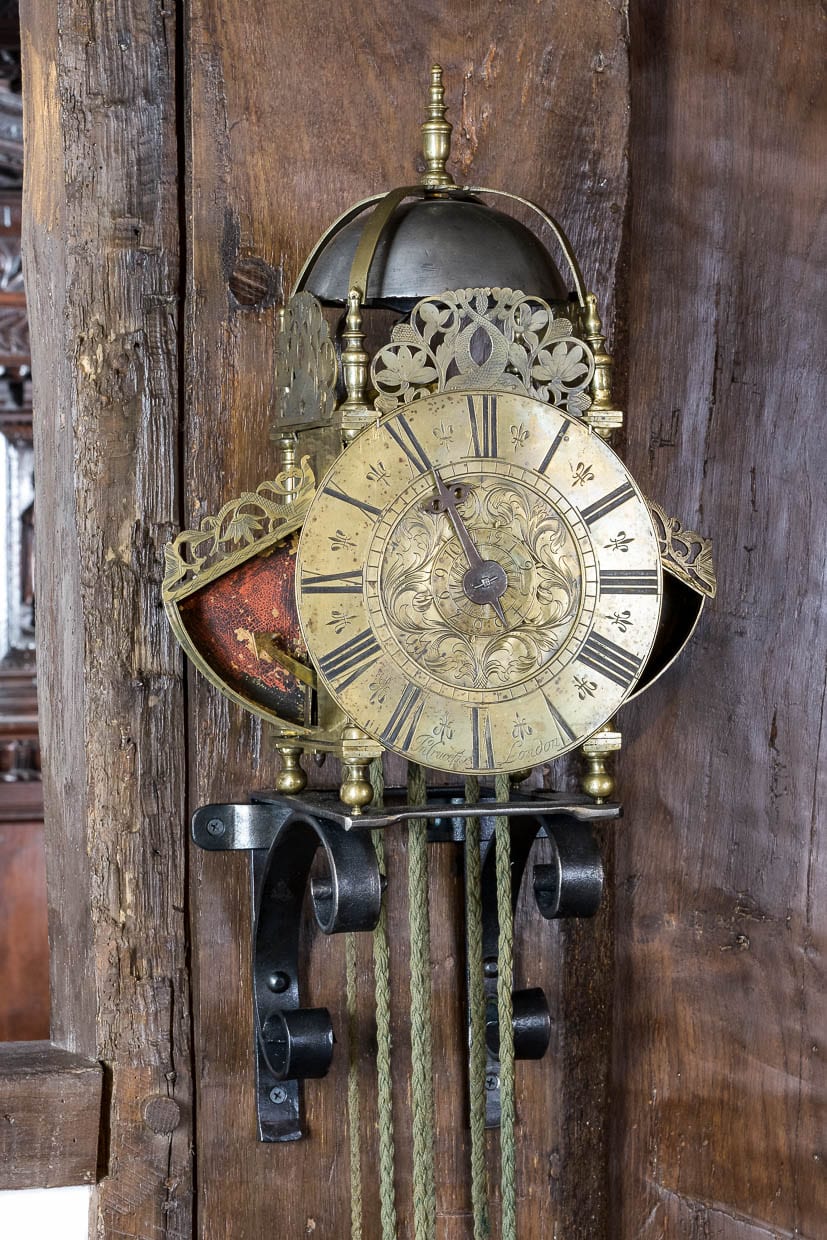John Crucefix winged lantern clock
Circa 1695 - 1710
London
W 7 1/2
Stock # Marh1410
SOLD
John Crucefix winged lantern clock with central verge pendulum. Signed Jno Crucefix London.
Brian Loomes notes:
A lantern clock which came to light recently set me enquiring into a little-known clockmaker named John Crucifex or Crucefix, for his name seems to have been spelled in a variety of ways. There was something a bit odd about John Crucefix, who seems to have made clocks, according to various estimates, as early as the 1680s, yet not to have joined the Clockmakers Company till 1712. Not many London clockmakers could get away with that, as the Company pressured all those who sought to practice the craft till they joined and paid their subscriptions.
Robert Crucefix, who I felt must surely have been related, was also little known, though one record said he worked in Sweetings Alley, which I think must be Swithens Alley in the Spitalfields district of London. When I later discovered Robert's will, this was confirmed, as he was then described as of the parish of Christ Church Spitalfields. The name Crucefix, however you spelled it, did not strike me as very English. I guessed it was a French name. I knew nothing about Spitalfields, but when I looked it up I was amazed to find that Spitalfields was a whole world of its own where immigrants settled in vast numbers, most particularly French ones. So gradually it all began to make sense.
Oddly enough the spelling of the name even by the family themselves seems very inconsistent. In his will, Robert senior spells his name Crucefix. On his clocks John sometimes spells it as Crucefix too, but also several times spells it as Crucifex. It seems they were not especially fussy, and so probably would not be offended if they knew that I have spelled it Crucefix consistently just out of tidiness.
John Crucefix was made free in the Clockmakers Company in 1712, as a Brother, implying he too learned his trade elsewhere than in the Company. His two sons, christened as Jean and Pierre, were apprenticed through the Clockmakers' Company as plain John and Peter - the Company founded almost a century earlier specifically 'to keep out Frenchmen' were not having any fancy Frenchified names. John was apprenticed in 1714 to Philip Abbot, Peter in 1716 to John Lewis. Their father John was then said to be of the parish of St. Botolph without Bishopsgate, which was the next parish adjacent to Christ Church Spitalfields, where Robert senior lived. Of John Crucefix's work I know of ten or eleven clocks, most being thirty-hour lantern clocks, one a thirty-hour hanging wall clock, and one a Turkish Market bracket clock, one described in Britten as a 'sheepshead' clock, by which he meant a lantern clock with a wider chapter ring (like the one pictured here), and one month duration longcase.
His lantern clocks would generally be expected to have wider chapter rings, by virtue of his having been influenced by the French style (which had wider rings) and by the fact that wider chapter rings were normal by about 1700, from which period some of his clocks must date. The wider style of chapter ring would project further than usual at each side outside the upright pillars, as here. The wide chapter ring also hangs down below the bottom of the frame into the space between the front 'feet', and also projects at the top into the front fret, which is cut back to receive it.
If we judge by the apparent date of his latest clock, John Crucefix must have been working till about 1730. Oddly enough some of his clocks clearly date well before the 1712 date of his joining the Company. We know he was working by 1699 and quite possibly earlier, judging by the style of his clocks. If he was the brother of Robert Crucefix senior, then it looks as if he too got away without joining for long enough, just as Robert junior did. It may be pertinent that he joined in 1712 in time enough to become an established member in order to get his own sons apprenticed through the Company in 1714 and 1716. We don't know whether John lived in St. Botolph's parish all along and simply used the Artillery Ground church, as his brother Robert did, or whether he later moved down to St. Botolph's parish after his children were born.

